Abstract
Considerable developments have occurred in the application of the method for growing Mycobacterium leprae in the mouse foot-pad since it was first described about 10 years ago. The method has been used to study growth curves and histology in normal and in thymectomized irradiated mice, to identify supposed isolates of Myco. leprae that have been made in tissue-culture or in non-living media, to evaluate tests of experimental vaccines, to investigate applications to clinical investigations (the loss of infectivity during chemotherapy as a means of monitoring a drug trial, the demonstration of drug-resistance, and the clinical problem of the patient who responds poorly to therapy), and to study new drugs—e.g., dapsone, acedapsone, clofazimine, and rifampicin.
Full text
PDF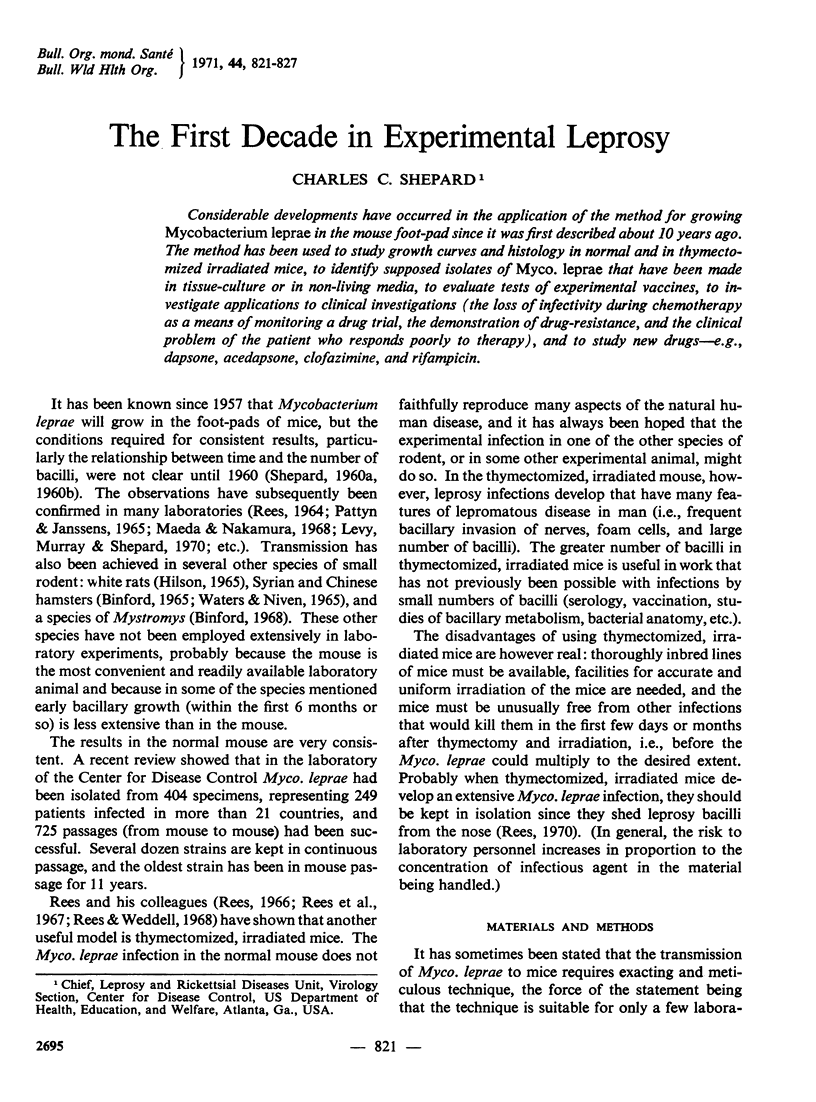
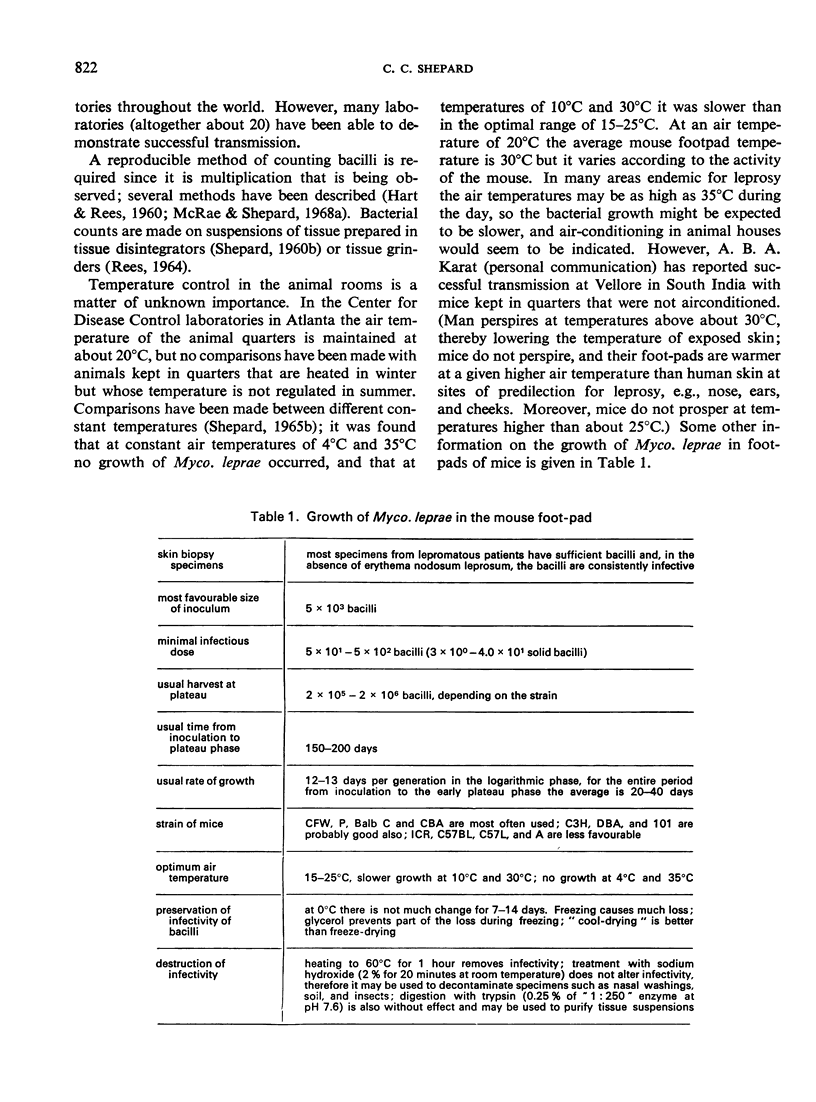
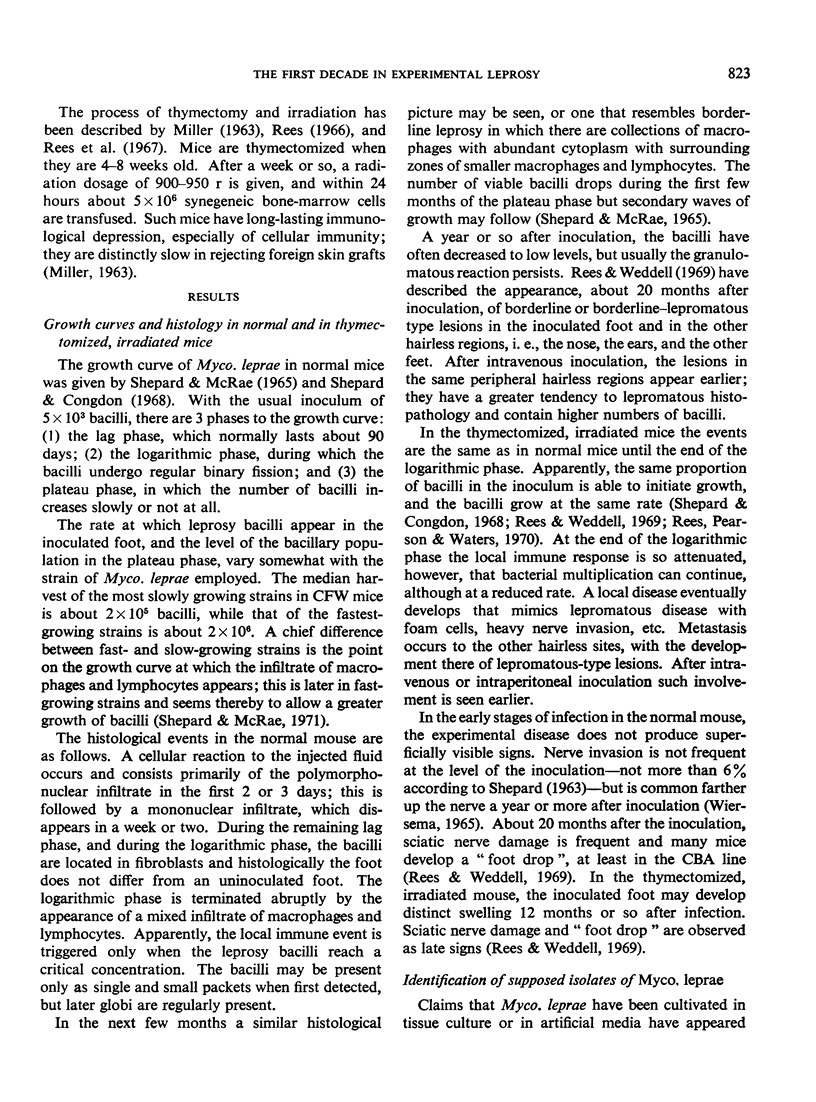
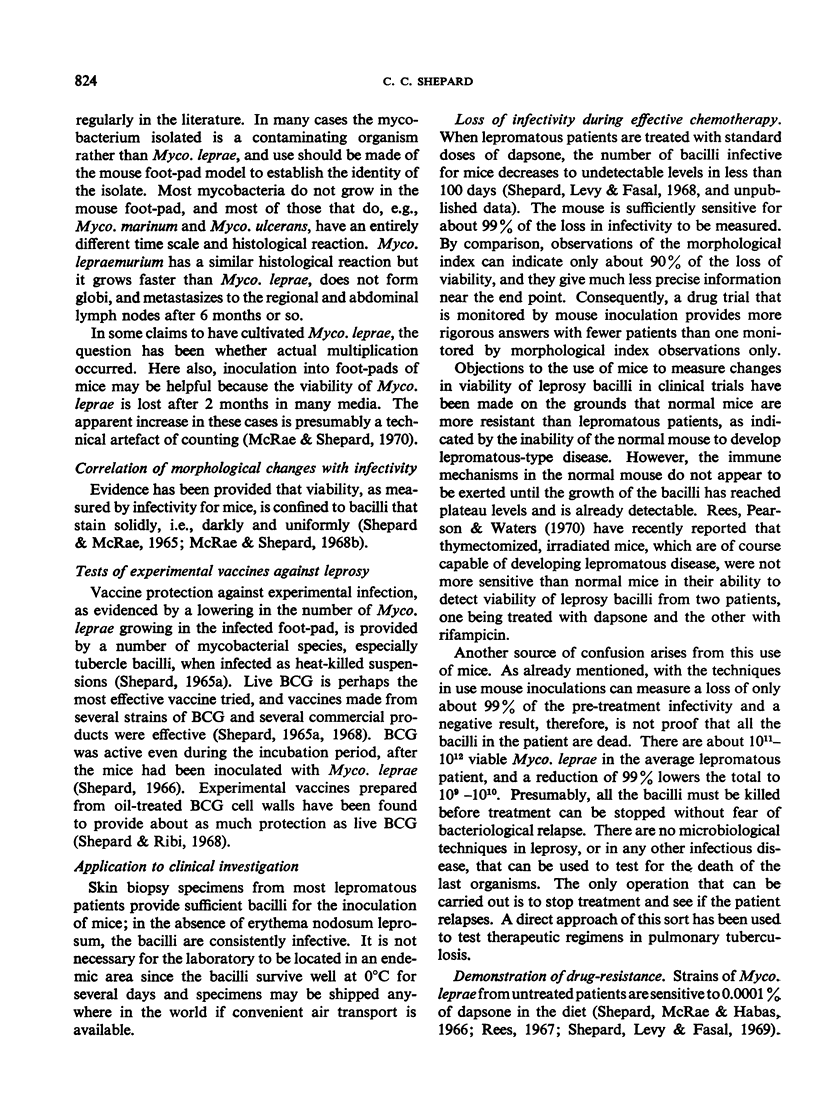
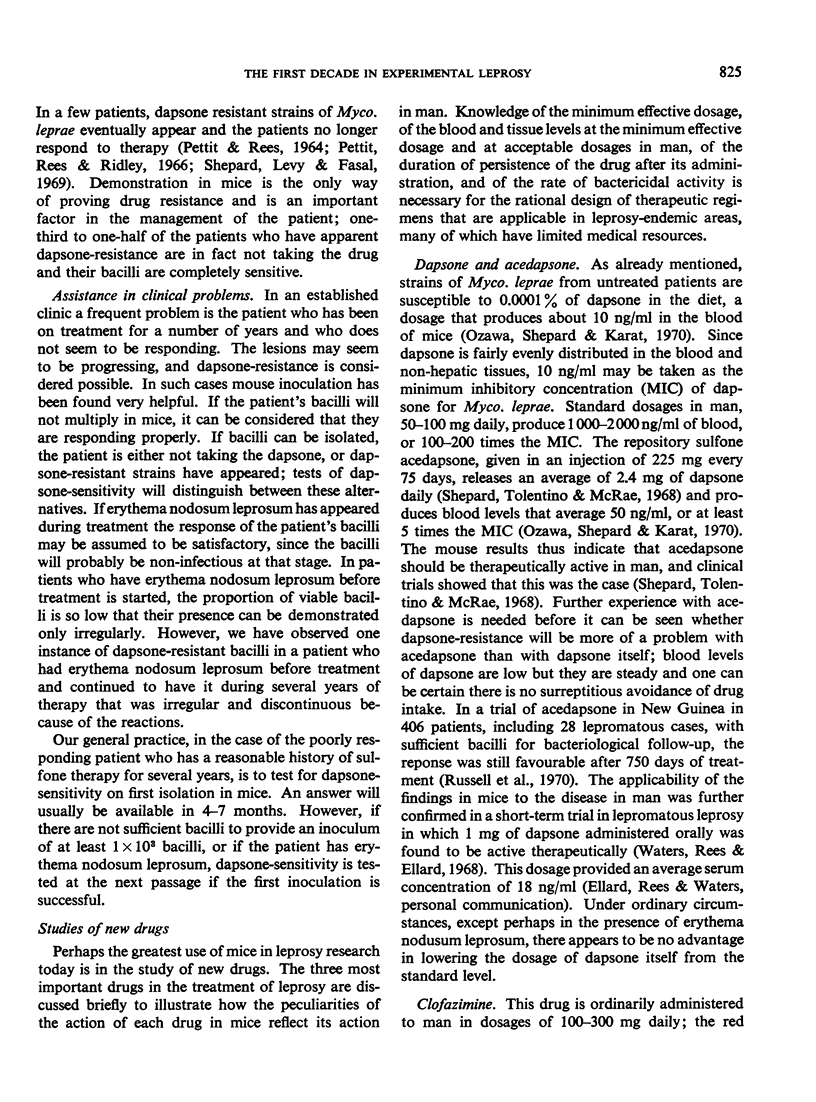
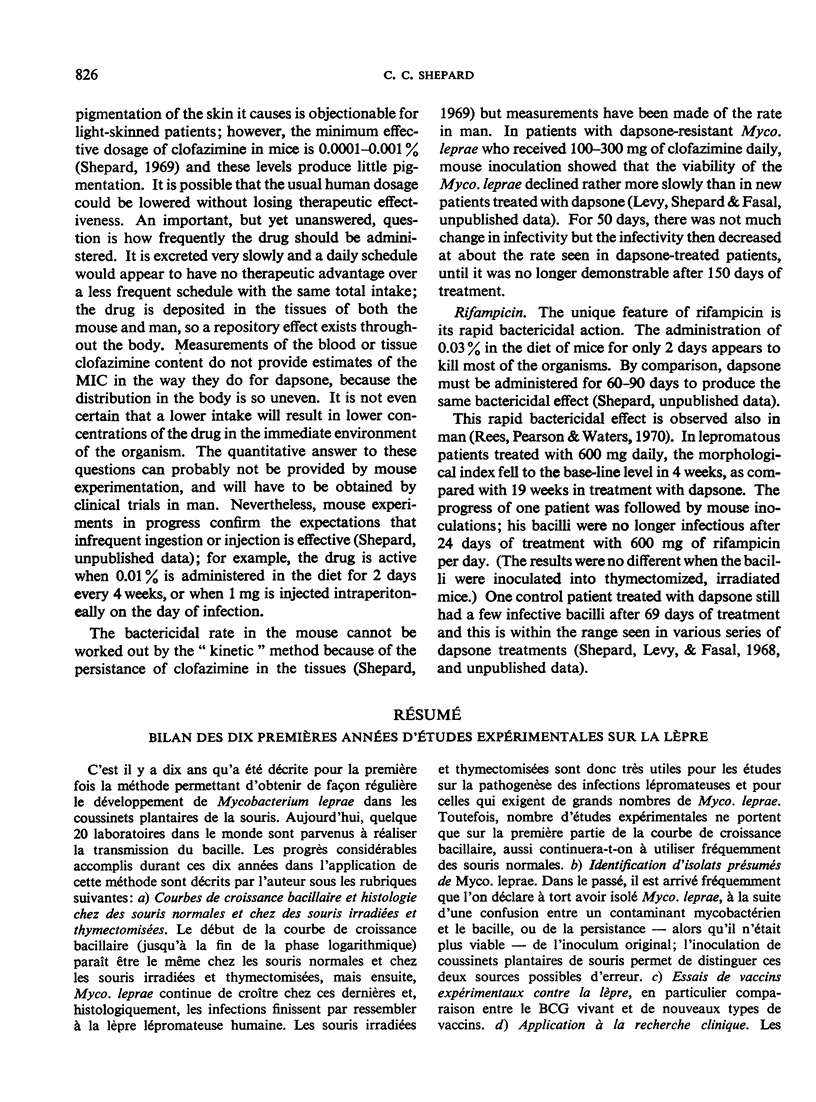
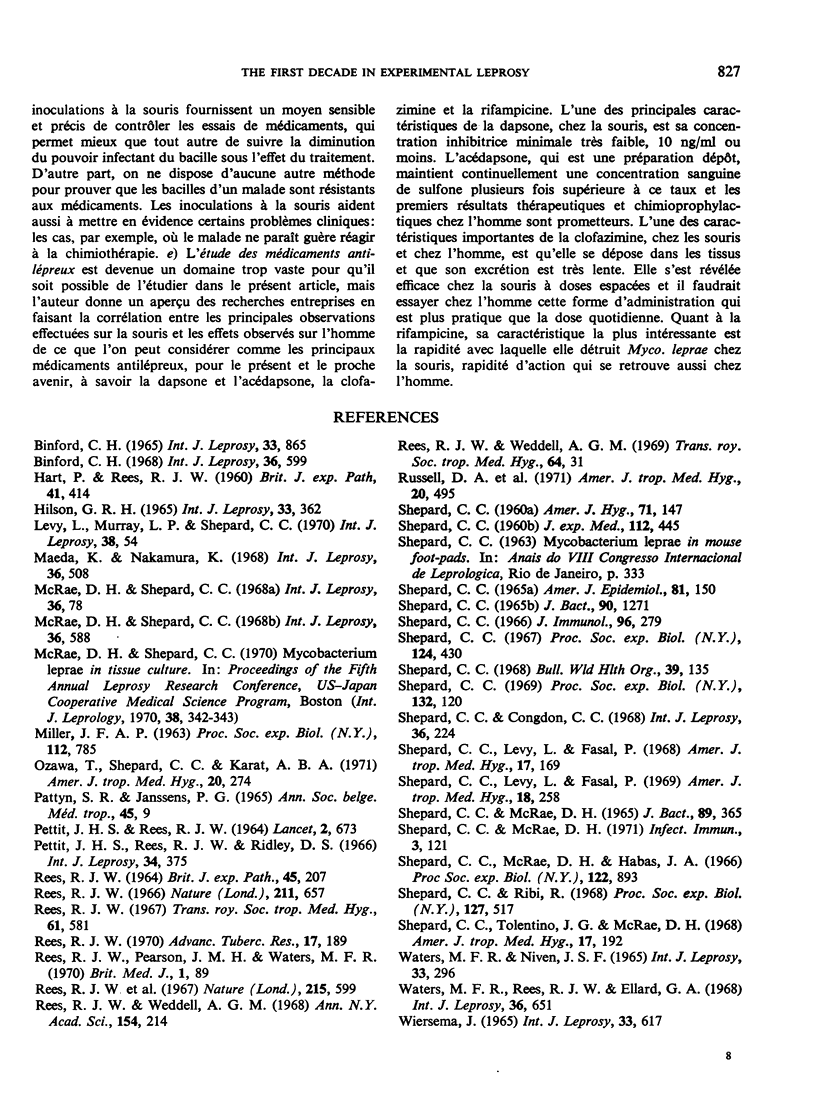
Selected References
These references are in PubMed. This may not be the complete list of references from this article.
- Binford C. H. Transmission of Mycobacterium leprae to animals. Nerve involvement in the ears of hamsters. Int J Lepr. 1965 Oct-Dec;33(4):865–874. [PubMed] [Google Scholar]
- HART P. D., REES R. J. Effect of macrocyclon in acute and chronic pulmonary tuberculous infection in mice as shown by viable and total bacterial counts. Br J Exp Pathol. 1960 Aug;41:414–421. [PMC free article] [PubMed] [Google Scholar]
- Levy L., Murray L. P., Shepard C. C. A comparative study of mouse foot pad inoculation of skin biopsy specimens from patients with lepromatous leprosy in San Francisco and Atlanta. Int J Lepr Other Mycobact Dis. 1970 Jan-Mar;38(1):54–59. [PubMed] [Google Scholar]
- Ozawa T., Shepard C. C., Karat A. B. Application of spectrophotofluorometric procedures to some problems in Mycobacterium leprae infections in mice and man treated with dapsone (DDS), diacetyl-DDS (DADDS), and di-formyl-DDS (DFD). Am J Trop Med Hyg. 1971 Mar;20(2):274–281. doi: 10.4269/ajtmh.1971.20.274. [DOI] [PubMed] [Google Scholar]
- PETTIT J. H., REES R. J. SULPHONE RESISTANCE IN LEPROSY. AN EXPERIMENTAL AND CLINICAL STUDY. Lancet. 1964 Sep 26;2(7361):673–674. doi: 10.1016/s0140-6736(64)92482-1. [DOI] [PubMed] [Google Scholar]
- Pettit J. H., Rees R. J., Ridley D. S. Studies on sulfone resistance in leprosy. I. Detection of cases. Int J Lepr Other Mycobact Dis. 1966 Oct-Dec;34(4):375–390. [PubMed] [Google Scholar]
- REES R. J. LIMITED MULTIPLICATION OF ACID-FAST BACILLI IN THE FOOT-PADS OF MICE INOCULATED WITH MYCOBACTERIUM LEPRAE. Br J Exp Pathol. 1964 Apr;45:207–218. [PMC free article] [PubMed] [Google Scholar]
- Rees R. J. Enhanced susceptibility of thymectomized and irradiated mice to infection with Mycobacterium leprae. Nature. 1966 Aug 6;211(5049):657–658. doi: 10.1038/211657a0. [DOI] [PubMed] [Google Scholar]
- Rees R. J. Leprosy. A preliminary review of the experimental evaluation of drugs for the treatment of leprosy. Trans R Soc Trop Med Hyg. 1967;61(4):581–595. doi: 10.1016/0035-9203(67)90111-3. [DOI] [PubMed] [Google Scholar]
- Rees R. J., Pearson J. M., Waters M. F. Experimental and clinical studies on rifampicin in treatment of leprosy. Br Med J. 1970 Jan 10;1(5688):89–92. doi: 10.1136/bmj.1.5688.89. [DOI] [PMC free article] [PubMed] [Google Scholar]
- Rees R. J. Recent advances in experimental leprosy. Bibl Tuberc. 1970;26:189–232. [PubMed] [Google Scholar]
- Rees R. J., Waters M. F., Weddell A. G., Palmer E. Experimental lepromatous leprosy. Nature. 1967 Aug 5;215(5101):599–602. doi: 10.1038/215599a0. [DOI] [PubMed] [Google Scholar]
- Rees R. J., Weddell A. G. Biology of the mycobacterioses. Experimental models for studying leprosy. Ann N Y Acad Sci. 1968 Sep 5;154(1):214–236. doi: 10.1111/j.1749-6632.1968.tb16711.x. [DOI] [PubMed] [Google Scholar]
- Rees R. J., Weddell A. G. Transmission of human leprosy to the mouse and its clinical implications. Trans R Soc Trop Med Hyg. 1970;64(1):31–47. doi: 10.1016/0035-9203(70)90194-x. [DOI] [PubMed] [Google Scholar]
- Russell D. A., Shepard C. C., McRae D. H., Scott G. C., Vincin D. R. Treatment with 4,4'-diacetyldiaminodiphenylsulfone (DADDS) of leprosy patients in the Karimui, New Guinea. Am J Trop Med Hyg. 1971 May;20(3):495–501. doi: 10.4269/ajtmh.1971.20.495. [DOI] [PubMed] [Google Scholar]
- SHEPARD C. C. Acid-fast bacilli in nasal excretions in leprosy, and results of inoculation of mice. Am J Hyg. 1960 Mar;71:147–157. doi: 10.1093/oxfordjournals.aje.a120098. [DOI] [PubMed] [Google Scholar]
- SHEPARD C. C., MCRAE D. H. MYCOBACTERIUM LEPRAE IN MICE: MINIMAL INFECTIOUS DOSE, RELATIONSHIP BETWEEN STAINING QUALITY AND INFECTIVITY, AND EFFECT OF CORTISONE. J Bacteriol. 1965 Feb;89:365–372. doi: 10.1128/jb.89.2.365-372.1965. [DOI] [PMC free article] [PubMed] [Google Scholar]
- SHEPARD C. C. VACCINATION AGAINST EXPERIMENTAL INFECTION WITH MYCOBACTERIUM LEPRAE. Am J Epidemiol. 1965 Mar;81:150–163. doi: 10.1093/oxfordjournals.aje.a120504. [DOI] [PubMed] [Google Scholar]
- Shepard C. C. Activity of repository sulfones against Mycobacterium leprae in mice. Proc Soc Exp Biol Med. 1967 Feb;124(2):430–433. doi: 10.3181/00379727-124-31757. [DOI] [PubMed] [Google Scholar]
- Shepard C. C., Congdon C. C. Increased growth of Mycobacterium leprae in thymectomized-irradiated mice after foot pad inoculation. Int J Lepr Other Mycobact Dis. 1968 Apr-Jun;36(2):224–227. [PubMed] [Google Scholar]
- Shepard C. C., Levy L., Fasal P. The sensitivity to Dapsone (DDS) of Mycobacterium leprae from patients with and without previous treatment. Am J Trop Med Hyg. 1969 Mar;18(2):258–263. [PubMed] [Google Scholar]
- Shepard C. C., McRae D. H. A method for counting acid-fast bacteria. Int J Lepr Other Mycobact Dis. 1968 Jan-Mar;36(1):78–82. [PubMed] [Google Scholar]
- Shepard C. C., McRae D. H., Habas J. A. Sensitivity of Mycobacterium leprae to low levels of 4,4'-diaminodiphenyl sulfone. Proc Soc Exp Biol Med. 1966 Jul;122(3):893–896. doi: 10.3181/00379727-122-31282. [DOI] [PubMed] [Google Scholar]
- Shepard C. C., McRae D. H. Hereditary Characteristic that Varies Among Isolates of Mycobacterium leprae. Infect Immun. 1971 Jan;3(1):121–126. doi: 10.1128/iai.3.1.121-126.1971. [DOI] [PMC free article] [PubMed] [Google Scholar]
- Shepard C. C. Minimal effective dosages in mice of clofazimine (B,663) and of ethionamide against Mycobacterium leprae. Proc Soc Exp Biol Med. 1969 Oct;132(1):120–124. doi: 10.3181/00379727-132-34162. [DOI] [PubMed] [Google Scholar]
- Shepard C. C., Ribi E. Cell walls from Mycobacterium tuberculosis (BCG) as vaccine against Mycobacterium leprae infections in mice. Proc Soc Exp Biol Med. 1968 Feb;127(2):517–521. doi: 10.3181/00379727-127-32729. [DOI] [PubMed] [Google Scholar]
- Shepard C. C. THE EXPERIMENTAL DISEASE THAT FOLLOWS THE INJECTION OF HUMAN LEPROSY BACILLI INTO FOOT-PADS OF MICE. J Exp Med. 1960 Sep 1;112(3):445–454. doi: 10.1084/jem.112.3.445. [DOI] [PMC free article] [PubMed] [Google Scholar]
- Shepard C. C. Temperature optimum of Mycobacterium leprae in mice. J Bacteriol. 1965 Nov;90(5):1271–1275. doi: 10.1128/jb.90.5.1271-1275.1965. [DOI] [PMC free article] [PubMed] [Google Scholar]
- Shepard C. C., Tolentino J. G., McRae D. H. The therapeutic effect of 4,4'-diacetyldiamino-diphenylsulfone (DADDS) in leprosy. Am J Trop Med Hyg. 1968 Mar;17(2):192–201. doi: 10.4269/ajtmh.1968.17.192. [DOI] [PubMed] [Google Scholar]
- Shepard C. C. Vaccination against human leprosy bacillus infections of mice: protection by BCG given during the incubation period. J Immunol. 1966 Feb;96(2):279–283. [PubMed] [Google Scholar]
- Wiersema J. P., Binford C. H., Chang Y. T. Nerve involvement. Comparison of experimental infections by Mycobacterium leprae and Mycobacterium lepraemurium. Int J Lepr. 1965 Jul-Sep;33(3 Suppl):617–633. [PubMed] [Google Scholar]


